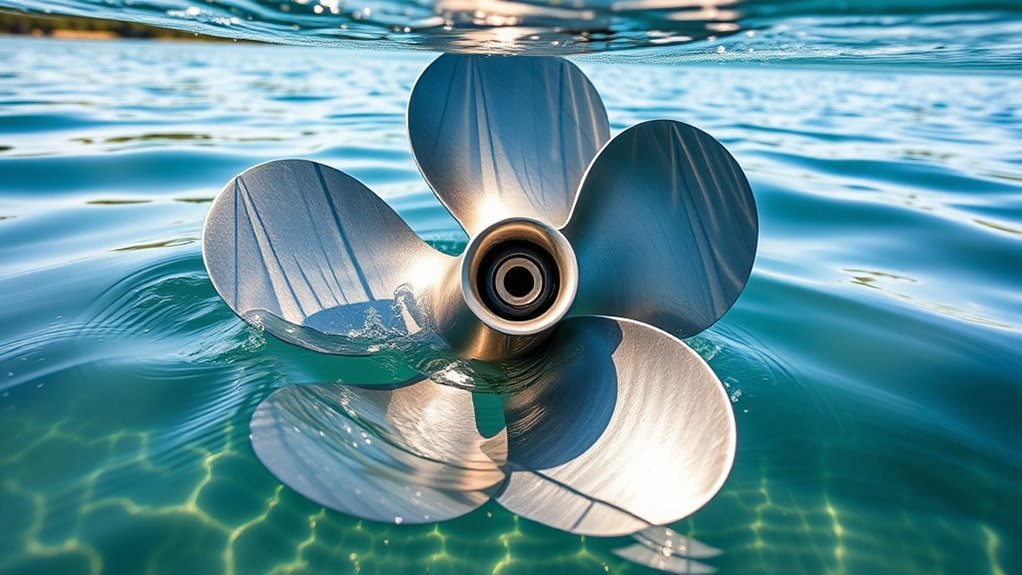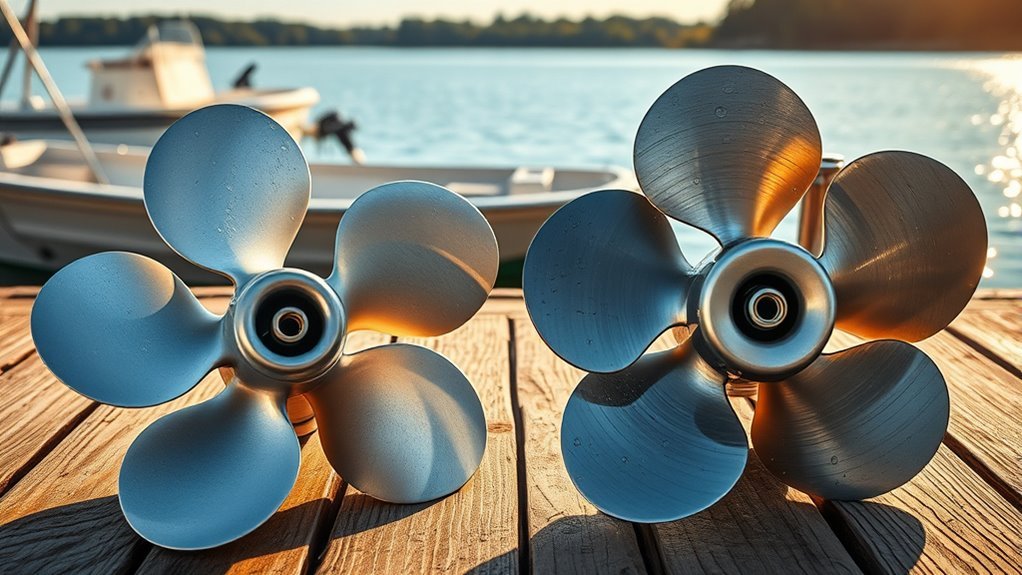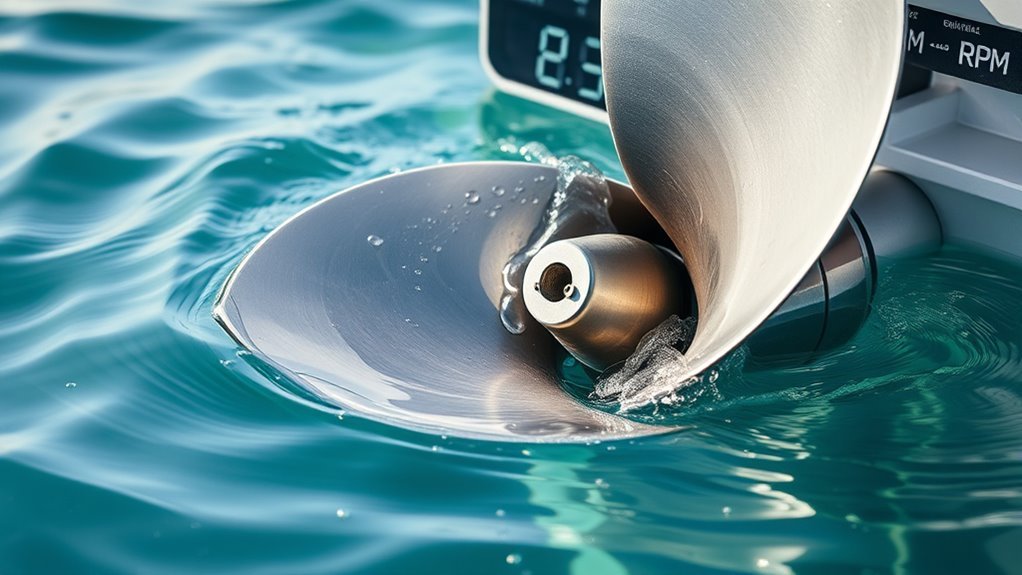We’ve all been there—dropping serious cash on a propeller that works great in salt water but falls flat on our favorite lake. Fresh water‘s lower density changes everything, and that “perfect” prop suddenly feels like it’s pushing through molasses. The material matters more than you’d think, pitch becomes a numbers game, and blade count? Well, that’s where things get interesting. Your boat’s telling you what it needs.
Understanding Propeller Specifications for Fresh Water Conditions

Why do so many boaters struggle with propeller performance when they hit fresh water?
It’s the specs, plain and simple.
Fresh water’s 2-4% lower density throws everything off.
Your propeller pitch needs adjustment—maybe dropping from 17 inches to 15 inches just to hit proper max rpm.
At 3700 feet altitude, that 8300 lb boat with 440 HP? Only managed 3300-3500 RPM instead of 4150. Ouch.
Stainless steel propellers deliver 2-3 knots more performance than aluminum thanks to thinner design and less flex.
The number of blades matters too—three-bladed props work great for fishing boats, especially in choppy seas.
Get the pitch wrong and you’re over-propped, missing that vital 5000-5500 RPM range.
Poor acceleration, potential damage, terrible fuel efficiency.
Not exactly the day you planned.
To enhance performance in open fresh water areas, opt for two-blade propellers that provide greater thrust for larger boats.
Three-Blade Vs Four-Blade Propellers for Lake and River Boating
Now that we’ve got the pitch and specs sorted out, let’s tackle the blade debate that’s got every lake and river boater scratching their heads.
Three-blade propellers?
They’re widely used for good reason.
Lightweight, sturdy, durable.
They won’t mess with your RPM in choppy waters.
Perfect for fishing boats across British Columbia’s lakes.
Four-blade boat propellers tell a different story.
That extra blade pushes more water, meaning you’ll plane quickly and get better hole shot performance.
Waterskiing, tubing, family fun – four-blades deliver.
Better bite for tight maneuvering too.
The catch?
More drag equals less efficiency.
But for recreational versatility, four-blades often win.
Three-blades balance thrust and reduced drag.
Four-blades tackle ventilation issues and boost acceleration.
Which is the best propeller?
Depends on your priorities.
For optimal performance, consider propeller maintenance to minimize power loss and extend your motor’s efficiency.
Aluminum Vs Stainless Steel Materials in Fresh Water Applications

Which material makes the difference between a prop that’ll last and one that’ll leave you stranded? It’s aluminum versus stainless steel, and the gap’s wider than you’d think.
Aluminum props are cheap. They’re also soft, bend easily, and basically crumple when they meet underwater rocks. But hey, they’re budget-friendly and easy to fix.
Stainless-steel props? They’re the real deal. These props maintain their shape at top speed, letting your boat go faster with thinner blades that slice through water like butter.
Here’s what stainless steel brings to fresh water:
- Speed increase of 2-3 knots over aluminum
- Better boat performance through reduced flex
- Superior strength that handles high loads
- Customization options for maximum efficiency
- Resistance to damage from obstacles
The performance difference is real. For added durability in freshwater, aluminum props can be enhanced with coating technologies to better resist wear and extend their lifespan.
Matching Propeller Pitch to Your Boat’s Performance Needs
You’ve got the perfect prop material, but if the pitch is wrong, you’re still going nowhere fast.
Finding the right prop pitch for your boat type isn’t rocket science, but it’s not guesswork either.
One inch of pitch adjustment changes your RPM by 100 to 200.
That’s significant forward motion we’re talking about.
Lower pitch props excel at acceleration.
Perfect for participating in water sports like waterskiing where you need torque off the line.
Higher pitch? That’s your cruising champion, delivering top-end speed and fuel efficiency.
Here’s the brutal truth: too much pitch and your engine won’t hit ideal RPM.
Too little? You’ll over-rev and potentially trash your motor.
Test different options.
Your boat will tell you what works.
Load Testing and RPM Optimization for Fresh Water Environments

How do we determine if our prop’s actually working in fresh water?
Load testing.
We’re talking light loads here – half tank of fuel, maybe two people aboard.
Your Mercury Marine outboard should hit that sweet 5,000 to 5,500 RPM range when you’re cruising with a full boat later.
Here’s what we’re checking during load testing:
- Engine reaches manufacturer’s recommended wide-open-throttle RPM range
- No over-propped conditions that’ll damage your motor
- Proper acceleration under varying load conditions
- RPM stays within redline limits at different altitudes
- Trailing edge performance remains consistent across conditions
That new prop from West Marine?
Test it properly.
Fresh water’s lower density means we might need different pitch than saltwater setups.
New boats especially need this verification – don’t assume the dealer got it right.
Frequently Asked Questions
What’s Better, a Stainless or Aluminum Prop?
We’d choose stainless steel for superior durability factors, corrosion resistance, and surface finish despite higher cost difference. Aluminum offers weight comparison advantages and maintenance ease, but stainless provides better flex tolerance.
Is a 19 or 21 Pitch Prop Faster?
A 21-pitch prop delivers 2-3 knots faster velocity comparison than 19-pitch. We’ll see higher pitch speed despite RPM effects reducing acceleration. Engine torque matches better, improving efficiency impacts while reducing slip factors for superior performance.
What Are Higher Quality Propellers Made Of?
We’ll find higher quality propellers made of stainless steel, bronze alloys, nickel bronze, composite materials, carbon fiber, polymer blends, and hybrid metals offering superior corrosion resistance and performance over standard aluminum options.
What Is Better, a 4 Blade Prop or a 3 Blade Prop on a Boat?
Like choosing between a sports car and pickup truck, we’d recommend four-blade props for superior hole shot, thrust comparison, and maneuverability effects, while three-blade props offer better blade efficiency and reduced vibration control.